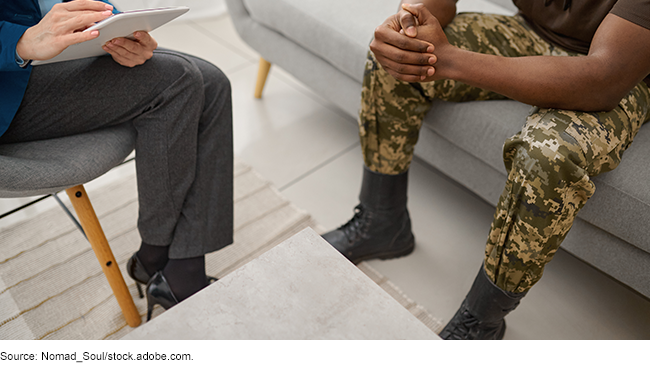DOD and VA Transition Programs: Recommendations for Improving Mental Health Support
Fast Facts
Thousands of service members transition to civilian life each year. We testified about our prior work on efforts to support their mental health during this transition.
While DOD and the Department of Veterans Affairs have programs to provide support, we found that improvements are needed to increase access to them.
For example, one DOD program relied on cold-calling to reach transitioning service members, but often had incorrect contact information. A VA program also struggled reaching younger people and those in rural areas with this approach.
Without effective outreach methods, service members may not be aware of available support.

Highlights
What GAO Found
The Departments of Defense (DOD) and Veterans Affairs (VA) administer a number of transition programs to support separating service members and veterans, including those with mental health needs. GAO has recently reported on some of these programs and on DOD's and VA's efforts to assess their effectiveness in facilitating access to mental health services during the transition period. Since January 2023, GAO has made 11 recommendations to DOD and three to VA to improve their support for the transitioning population. As of August 2024, the departments had taken steps to implement some of these recommendations. Fully addressing them would help ensure that transitioning service members and veterans have the support they need and deserve.
- DOD's inTransition program. This program is intended to help facilitate connections to mental health services for service members and veterans during times of transition to ensure the continuity of their care. In July 2024, GAO reported that inTransition did not successfully connect with over 70 percent of the eligible service members it identified in 2022. This was due, in part, to its reliance on telephone calls and not other forms of outreach, such as email. GAO recommended that inTransition expand its outreach methods. DOD did not provide a formal response to this recommendation.
- DOD's warm handovers. To assist service members who may be at risk for a difficult transition—including those with mental health needs—DOD has a process to provide a person-to-person connection, known as a “warm handover,” to other agencies. In March 2024, GAO reported that DOD does not reliably verify that warm handovers occur and has not assessed their helpfulness. GAO made multiple recommendations, including that DOD develop a plan to assess the helpfulness of warm handovers. DOD concurred with the recommendations and is working to implement them.
- VA's Solid Start program. This program proactively connects new veterans with resources and benefits and designates transitioning service members as “priority veterans” for outreach if they received mental health care in the year prior to separation. In January 2023, GAO reported that VA had not collaborated with veterans organizations to address outreach challenges, such as using cold calls to contact veterans or connecting with hard-to-reach veterans. GAO recommended that VA collaborate with veterans organizations to identify and address any outreach gaps and assess outreach strategies for hard-to-reach veterans. VA concurred and has implemented the recommendation.
- DOD-VA Joint Executive Committee's assessment of programs. This committee serves as an interagency body for coordinating the resources and benefits of the departments, including military transition assistance activities. In July 2024, GAO reported that the Committee had not assessed the overall effectiveness of the departments' various efforts to facilitate access to mental health services for transitioning service members and veterans and made a recommendation that it do so. VA concurred with this recommendation, but DOD did not provide a formal response.
Why GAO Did This Study
Thousands of service members transition from military service to civilian life each year—about 175,000 in calendar year 2022. Research has shown that during this transition period service members are especially vulnerable. One study found that the suicide rate within the first year of separation was about 2.5 times higher than for the active duty population.
To help address this concern, DOD and VA have various programs and processes available to support transitioning service members and veterans who may need mental health assistance. GAO's past work has identified areas for improvement to these programs and processes.
This statement summarizes GAO's recent work examining DOD's and VA's efforts to support service members and veterans with mental health needs during the transition from military to civilian life. This includes recommendations GAO made regarding (1) DOD's inTransition program; (2) DOD's warm handover process; (3) VA's Solid Start program; and (4) the DOD-VA Joint Executive Committee's assessment of mental health services across the transition continuum.
This statement is primarily based on three GAO reports issued between January 2023 and July 2024 (GAO-23-105699, GAO-24-106248, and GAO-24-106189). GAO also reviewed documents from DOD and VA related to steps the agencies have taken to address GAO's recommendations.
For more information, contact Alyssa M. Hundrup at (202) 512-7114 or hundrupa@gao.gov or John D. Sawyer at (202) 512-7215 or sawyerj@gao.gov.
